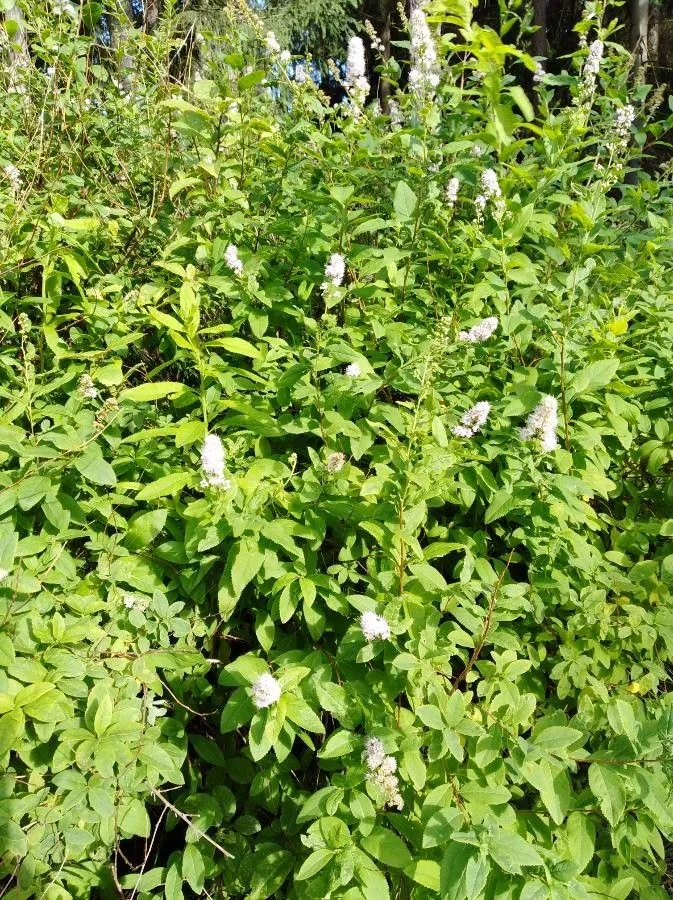
Author: Du Roi
Bibliography: Harbk. Baumz. 2: 430 (1772)
Year: 1772
Status: accepted
Rank: species
Genus: Spiraea
Vegetable: False
Observations: WC. & E. Canada to NC. & E. U.S.A.
Meadowsweet, scientifically known as Spiraea alba, is a cherished plant species belonging to the Rosaceae family. This perennial beauty is native to wide regions extending from Western and Eastern Canada to North Central and Eastern United States, showcasing its adaptability and wide ecological footprint.
Recognized for its grace and splendor, Meadowsweet typically thrives in moist, well-drained soils often found in wetlands, meadows, and along stream banks. Its preference for such areas highlights its role in natural habitats, contributing to soil stabilization and providing habitat and nectar for various pollinating insects, especially bees and butterflies.
In botanical literature, Spiraea alba was first documented by Du Roi in the second volume of “Harbk. Baumz.” published in 1772. This citation underscores its longstanding recognition and the plant’s significance in botanical studies and horticulture.
Meadowsweet showcases clusters of petite, white flowers that bloom in summer, creating a stunning, cloud-like display. These blossoms emit a sweet fragrance, adding to the plant’s allure and making it a favorite among garden enthusiasts and landscape designers. The leaves of Spiraea alba contribute to its ornamental value, with their lance-shaped form and finely toothed edges providing a delicate, textured contrast to its striking floral sprays.
Beyond its aesthetic appeal, Spiraea alba also holds traditional medicinal uses. Historically, various parts of the plant have been utilized for their potential therapeutic properties, underlining its value not only as a decorative plant but also as a species of interest in herbal medicine.
In summary, Meadowsweet, or Spiraea alba, is more than just a pretty face in the garden—it’s a plant with deep roots in both historical documentation and natural landscapes, celebrated for its beauty, ecological contributions, and traditional medicinal potential.
Lit: baltoji lanksva
Dan: hvid spiræa
Eng: meadowsweet, pale bridewort, white meadowsweet
Fra: spirée blanche
Deu: weißer spierstrauch
Nld: witte spirea, witte pluimspirea
Lav: balt, platlapu spireja
Nob: hvitspirea
Nno: kvitspirea
Hun: lándzsáslevelű bajnóca
Ces: tavolník bílý
Fin: valkopajuangervo
Swe: valkopajuangervo, vitspirea
Cym: erwain gwyn
En: Meadowsweet, Pale bridewort, White meadowsweet, SPIREA
Be: Спірэя белая
Cs: Tavolník bílý
Da: Hvid spiræa
Nl: Witte pluimspirea, Witte spirea
Et: Valge enelas
Fi: Valkopajuangervo
Fr: Spirée blanche
De: Weißer Spierstrauch
Hu: Lándzsáslevelű bajnóca
Lv: Balt, Platlapu spireja
Lt: Baltoji lanksva
Nb: Hvitspirea
Nn: Kvitspirea
Sv: Vitspirea, Valkopajuangervo
Cy: Erwain gwyn
© copyright of the Board of Trustees of the Royal Botanic Gardens, Kew.
Taken Jul 26, 2020 by Dieter Wagner (cc-by-sa)
Taken Aug 25, 2015 by EOL − botany08 (cc-by)
Taken Sep 1, 2021 by Dieter Wagner (cc-by-sa)
Taken Nov 26, 2021 by Dieter Wagner (cc-by-sa)
Taken Sep 1, 2021 by Dieter Wagner (cc-by-sa)
Taken Aug 2, 2021 by Kaitlyn Foy (cc-by-sa)
Taken Aug 13, 2020 by Dieter Wagner (cc-by-sa)
Taken Aug 22, 2022 by William Coville (cc-by-sa)
Taken Sep 1, 2021 by Dieter Wagner (cc-by-sa)
Taken Sep 1, 2021 by Dieter Wagner (cc-by-sa)
Taken Aug 22, 2022 by William Coville (cc-by-sa)
Taken Aug 13, 2020 by Dieter Wagner (cc-by-sa)
Taken Jul 16, 2022 by Jacques Zuber (cc-by-sa)
Taken May 12, 2021 by julien daube (cc-by-sa)
Taken Sep 2, 2021 by Robert Kropp (cc-by-sa)
Taken Jan 17, 2017 by Yoan MARTIN (cc-by-sa)
Taken Jun 25, 2014 by Tela Botanica − Yoan MARTIN (cc-by-sa)
Taken Jul 11, 2020 by Pricia (cc-by-sa)
Taken Jul 16, 2022 by Jacques Zuber (cc-by-sa)
Taken Jan 17, 2017 by Yoan MARTIN (cc-by-sa)
Taken Jul 7, 2021 by Vicki Brown (cc-by-sa)
Taken Sep 10, 2020 by Joseph Moulaison (cc-by-sa)
Taken Aug 26, 2021 by Richard Wideman (cc-by-sa)
Taken Aug 2, 2021 by Kaitlyn Foy (cc-by-sa)
Taken Aug 9, 2021 by Théo Boeglin (cc-by-sa)
Taken Jun 10, 2020 by Eldsyn (cc-by-sa)
Taken May 19, 2021 by dimpel (cc-by-sa)
Taken Jun 21, 2020 by Kimberley Wright (cc-by-sa)
Taken Nov 21, 2007 by EOL − Chicago Botanic Garden 2007 (cc-by-nc-sa)
Taken Nov 21, 2007 by EOL − Chicago Botanic Garden 2007 (cc-by-nc-sa)
Growth form: Multiple Stem
Growth habit: Shrub
Growth rate: Moderate
Ph maximum: 6.8
Ph minimum: 4.3
Light: 7
Atmospheric humidity: 7
Soil nutriments: 5
Family: Myrtaceae Author: (F.Muell.) K.D.Hill & L.A.S.Johnson Bibliography: Telopea 6: 402 (1995) Year: 1995 Status:…
Family: Rubiaceae Author: Pierre ex A.Froehner Bibliography: Notizbl. Bot. Gart. Berlin-Dahlem 1: 237 (1897) Year:…
Family: Sapindaceae Author: Koidz. Bibliography: J. Coll. Sci. Imp. Univ. Tokyo 32(1): 38 (1911) Year:…
Family: Asteraceae Author: A.Gray Bibliography: Pacif. Railr. Rep.: 107 (1857) Year: 1857 Status: accepted Rank:…
Family: Fabaceae Author: Medik. Bibliography: Vorles. Churpfälz. Phys.-Ökon. Ges. 2: 398 (1787) Year: 1787 Status:…
Family: Aspleniaceae Author: (Cav.) Alston Bibliography: Bull. Misc. Inform. Kew 1932: 309 (1932) Year: 1932…